The Contribution Of EU Workers In The Social Care Workforce In Scotland 2022
Scottish Government commissioned Ipsos to carry out a repeat of a 2017 study into the impact of Brexit on the UK workforce.
4. Perspectives on recruitment and retention
This chapter explores survey participants' views on recruitment and retention in the social care sector, including the extent to which they had found it easier or more difficult over the last year to recruit and retain EU workers.
Recruitment
Ease of recruiting staff in general
The perceived ease of recruiting staff over that last 12 months varied depending on the types of post being recruited. However, since 2018, a much larger proportion of participants reported that it has got harder to recruit across all types of post.
As shown in Table 4.1, over three-quarters (77%) of those who had tried to recruit care staff or practitioners said the process had become more difficult in the last year. The corresponding figure in 2018 was 44%. Around two-thirds (64%) of those who had tried to recruit NMC registered nurses said the process had become more difficult in the last year (compared to 52% in 2018). There has also been large increases in the proportion of participants reporting that it has got harder to recruit auxiliary staff (57% from 21% in 2018) and managers (45% compared to 19% in 2018).
| Auxiliary staff | Care staff/ practitioner | NMC Registered nurses | Managers | Other | |
|---|---|---|---|---|---|
| % | % | % | % | % | |
| A lot easier | 2% | 1% | 2% | 1% | 1% |
| A little easier | 2% | 1% | 1% | 2% | 2% |
| No change | 37% | 21% | 29% | 47% | 38% |
| A little more difficult | 9% | 10% | 5% | 7% | 8% |
| A lot more difficult | 48% | 67% | 59% | 38% | 48% |
| Don't know | 2% | 0% | 4% | 5% | 3% |
| Easier | 4% | 2% | 3% | 3% | 3% |
| More difficult | 57% | 77% | 64% | 45% | 57% |
| Base | 594 | 581 | 201 | 374 | 277 |
| Easier (2018 estimate) | 8 | 7 | 9 | 5 | 6 |
| More difficult (2018 estimate) | 21 | 44 | 52 | 19 | 24 |
The results for auxiliary posts suggest that dificulties recruiting for such posts are not limited to particular sub-sectors: the proportion who said that it was more difficult recruiting for such posts than a year ago ranged from 43% in nurse agencies to 61% in care homes for adults.
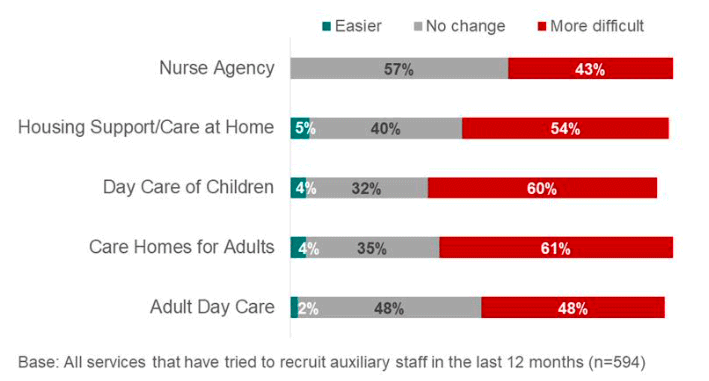
The type of post participants had most commonly experienced increased difficulty recruiting for was care staff, with the majority of participants in all sub-sectors reporting increased difficulties. The figures ranged from 66% in adult day care to 80% in day care of children.
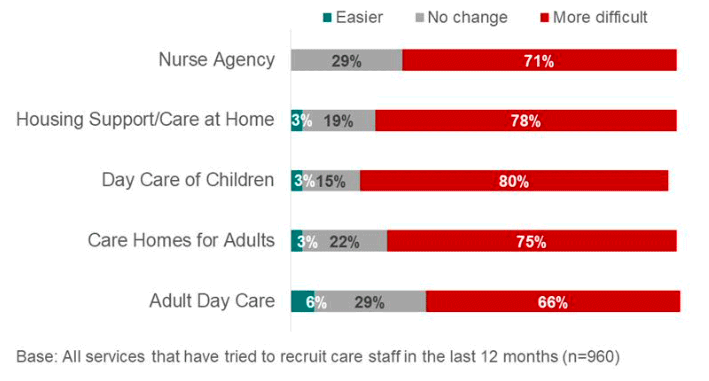
Similarly, all sub-sectors reported difficulties in recruiting NMC registered nurses. Figure 4.3 shows that this difficulty was felt most acutely among participants working in care homes for adults (72%) nurse agencies (71%), and housing support/care at home (67%).
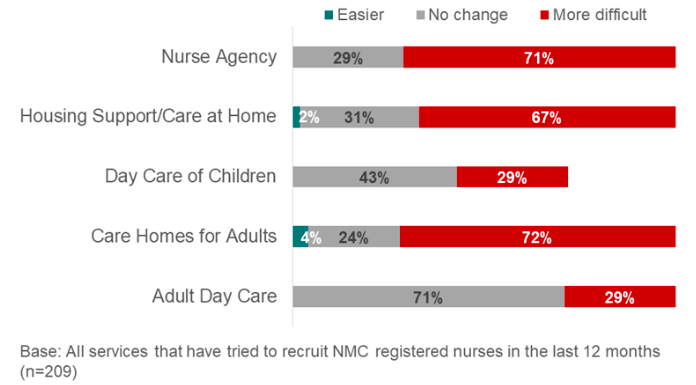
Recruitment difficulties to managerial posts was most prevalent among participants in the Day Care of Children sub-sector with 61% reporting increased difficulties over the last year. (Figure 4.4).
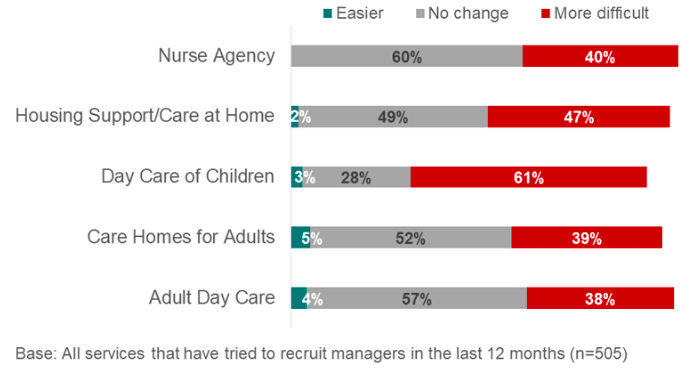
Ease of recruiting EU staff
The proportion of managers who reported a drop in the number of applications received from EU27 nationals in the last 12 months was higher across all staff types compared to 2018. With respected to care staff and practitioners posts, 37% of managers reported a drop in applications from EU27 nationals, compared to 13% in 2018. For auxiliary staff, the corresponding figure was 29% compared to 11% in 2018, and for NMC registered nurses, the corresponding figures was 27% compared to 14% in 2018.
| Auxiliary staff | Care staff/ practitioner | NMC Registered nurses | Managers | Other | |
|---|---|---|---|---|---|
| % | % | % | % | % | |
| A lot more | 1% | 2% | 1% | 0% | 1% |
| A little more | 2% | 4% | 1% | 0% | 1% |
| No change | 60% | 49% | 61% | 67% | 63% |
| Slightly fewer | 6% | 8% | 3% | 4% | 4% |
| Far fewer | 23% | 29% | 23% | 17% | 23% |
| Don't know | 8% | 9% | 12% | 11% | 8% |
| More | 3% | 5% | 1% | 1% | 2% |
| Fewer | 29% | 37% | 27% | 21% | 27% |
| Base | 577 | 854 | 261 | 516 | 359 |
| More (2018 estimate) | 10 | 15 | 6 | 2 | 6 |
| Fewer (2018 estimate) | 11 | 13 | 14 | 4 | 6 |
Participants from the private sector were consistently more likely than those working in other sectors to report a drop in the number of applications they had received from EU27 nationals in the last 12 months for auxiliary staff, NMC Registered nurses and managers (Table 4.3).
There was no significant difference between the private sector and the voluntary sector in the proportion of participants reporting fewer applications for care staff and practitioners (42% compared to 38%).
| Auxiliary staff | Care staff/ practitioner | NMC Registered nurses | Managers | Other | |
|---|---|---|---|---|---|
| % | % | % | % | % | |
| All employers | 29% | 37% | 27% | 21% | 27% |
| Private sector | 35% | 42% | 35% | 28% | 31% |
| Voluntary sector | 26% | 38% | 15% | 18% | 28% |
| Local authority | 13% | 15% | 7% | 4% | 10% |
| All employers (2018 estimate) | 11% | 13% | 14% | 4% | 6% |
The survey asked all those who employed any staff whether changes in the UK's immigration policies over the last five years had had any impact on their ability to meet their recruitment needs[19]
| All adult social care | All child-care | All | |
|---|---|---|---|
| % | % | % | |
| A lot/A little easier | 2% | 1% | 1% |
| No impact | 56% | 78% | 65% |
| A little more difficult | 13% | 8% | 11% |
| A lot more difficult | 29% | 13% | 23% |
| Total | 100% | 100% | 100% |
Overall, around two-thirds (65%) said that changes had had no impact, and around a third (34%) said that changes had made recruitment a little more, or a lot more difficult (11% and 23% respectively). (Table 4.4). More managers in the adult social care sectors than in the chlidcare sectors said that changes had made meeting their recruitment needs more difficult (42% compared to 29%).
There were some differences by sub-sector with more managers in the voluntary sector saying that changes had made recruiment more difficult (38%) compared to those in the private and public sectors (33% and 26% respectively).
Retention
Ease of retaining staff in general
The survey results suggest that staff retention has also become more challenging for managers since 2018. Almost three in five participants (58%) reported that there had been increased difficulties in retaining care staff and practitioners. The corresponding figure in 2018 was 26%.
Overall, 37% reported increased difficulties retaining NMC registered nurses compared to 18% in 2018, while 34% said the same in relation to auxiliary staff compared to 10% in 2018, and 27% reported increased difficulties in relation to retaining managers compared to 8% in 2018.
| Auxiliary staff | Care staff/ practitioner | NMC Registered nurses | Managers | Other | |
|---|---|---|---|---|---|
| % | % | % | % | % | |
| A lot easier | 2% | 2% | 2% | 2% | 1% |
| A little easier | 1% | 2% | 1% | 1% | 1% |
| No change | 61% | 38% | 57% | 67% | 58% |
| A little more difficult | 13% | 24% | 13% | 10% | 13% |
| A lot more difficult | 22% | 34% | 24% | 16% | 25% |
| Don't know | 1% | 0% | 4% | 3% | 2% |
| Easier | 3% | 4% | 3% | 3% | 2% |
| More difficult | 34% | 58% | 37% | 27% | 38% |
| Base | 641 | 991 | 244 | 683 | 363 |
| Easier (2018 estimate) | 7 | 7 | 8 | 5 | 5 |
| More difficult (2018 estimate) | 10 | 26 | 18 | 8 | 10 |
Participants from the private sector were consistently more likely than those working in other sectors to report increased difficulties retaining staff for all types of post (Table 4.6). There were no clear patterns by sub-sector.
| Auxiliary staff | Care staff/ practitioners | NMC Registered nurses | Managers | Other | |
|---|---|---|---|---|---|
| % | % | % | % | % | |
| All employers | 34% | 58% | 37% | 27% | 38% |
| Private sector | 46% | 71% | 48% | 37% | 48% |
| Voluntary sector | 22% | 47% | 20% | 24% | 32% |
| Local authority | 23% | 38% | 10% | 5% | 16% |
| All employers (2018 estimate) | 10 | 26 | 18 | 8 | 10 |
Ease of retaining EU staff
In terms of the retention of EU staff specifically, most participants said that there had been no change in the last twelve months for all job types, ranging from 70% for care staff and practitioners to 84% for managers (Table 4.7).
However, the survey results suggest increased difficulties compared to 2018 across all staff types. Overall, 24% reported increased difficulties retaining EU care staff and practitioners compared to 8% in 2018. Similarly, 17% said likewise in relation to Auxiliary staff compared to 4% in 2018, 13% said likewise for NMC registered nurses compared to 8% in 2018, and 11% said the same for managers compared to 2% in 2018.
| Auxiliary staff | Care staff/ practitioners | NMC Registered nurses | Managers | Other | |
|---|---|---|---|---|---|
| % | % | % | % | % | |
| A lot easier | 0% | 1% | 0% | 0% | 0% |
| A little easier | 0% | 1% | 0% | 0% | 0% |
| No change | 79% | 70% | 80% | 84% | 80% |
| A little more difficult | 5% | 11% | 4% | 5% | 5% |
| A lot more difficult | 11% | 14% | 9% | 6% | 11% |
| Don't know | 4% | 5% | 7% | 5% | 4% |
| Easier | 0% | 2% | 0% | 0% | 0% |
| More difficult | 17% | 24% | 13% | 11% | 16% |
| Base | 435 | 626 | 214 | 436 | 289 |
| Easier (2018 estimate) | 3 | 3 | 3 | 1 | 2 |
| More difficult (2018 estimate) | 4 | 8 | 8 | 2 | 4 |
Again, small base sizes prevent full, robust sub-group analysis of the results and no other sub-sectoral differences were detectable.
Over a quarter of participants (26%) in total said that EU staff had left their service in the last 12 months, compared to 14% who said the same in 2018. There was considerable variation by sub-sector ranging from a low of 11% in adult day care services, to 68% working in nurse agencies (Figure 4.5). This is likely to reflect the varying prevalence of EU nationals in these different sub-sectors.
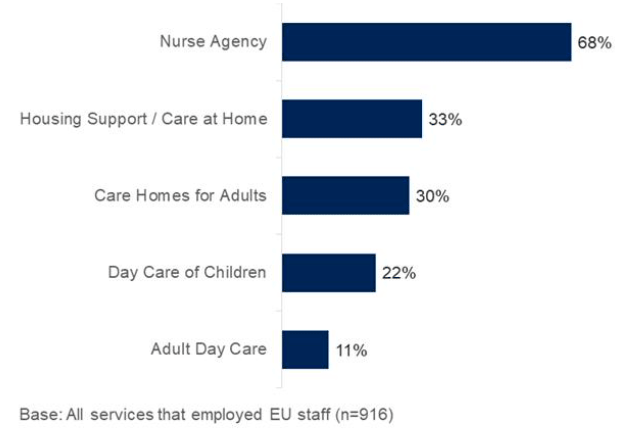
Participants cited a wide range of reasons why EU staff had left their service over the last year but the most common of these were promotion or to take up a better job elsewhere (30%); relocation to a EU country (24%); to pursue a career change or study (24%); and unhappy with aspects of their job (23%). Brexit-related concerns were mentioned by 14% (Figure 4.6).
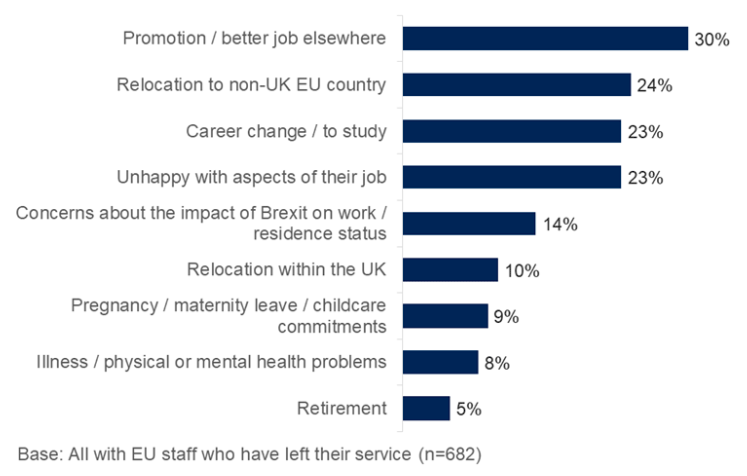
Both Brexit and COVID-19 were mentioned frequently in the open-ended comments in the survey. A sizeable number of participants mentioned that the pandemic had lead to staff moving back home to be with family.
"The Covid crisis. We have seen it go from very difficult to even more difficult to retain staff. There are not many new EU nationals coming into the UK now or who are applying for jobs."
Housing support / Care at home participant (voluntary sector), East
Additionally, a number of comments related to legislation around immigration and employment rights.
"After Brexit, there are less EU staff looking for jobs, and some of those who we had working with us have moved on. Personally, I think they do not feel welcome in the UK. I work extra hard to make them feel valued in Scotland. We have had some amazing EU workers over the years and its a crying shame that they have to jump through so many hoops to fill jobs that UK citizens don't want."
Nursing agency participant (private sector), East
It is difficult to disentangle the impact of Brexit and the impact of the pandemic. One participant noted:
"It is difficult to differentiate between the difficulty in retaining staff due to Covid and difficulty retaining staff due to Brexit. I would venture that most of our visa-related resignations are not from EU citizens but from non-EU, citizens."
Housing support / Care at home participant (voluntary sector), East
These issues are discussed further in the next chapter.
Summary
While the survey found some variation in the ease of recruiting different categories of staff into the social care sectors, all types of post had seen increases in recruitment difficulties since 2018.
Over three-quarters (77%) of those who had tried to recruit care staff or practitioners said the process had become more difficult in the last year, compared to 44% in 2018. Around two-thirds (64%) of those who had tried to recruit NMC registered nurses said the process had become more difficult in the last year (compared to 52% in 2018). There has also been large increases in the proportion of participants reporting that it had got harder to recruit auxiliary staff and managers.
The survey suggests that staff retention had also become more challenging since 2018. Almost three in five participants (58%) reported that there had been increased difficulties in retaining care staff and practitioners. The corresponding figure in 2018 was 26%. In terms of retention of EU staff specifically, while most participants said that there had been no change in the last twelve months for all job types - ranging from 70% for care staff and practitioners to 84% for managers – the survey suggested increased difficulties compared to 2018 of retaining EU staff in all types of role.
In terms of reasons EU staff had left the sector, these were many and varied. Brexit was mentioned along with more 'everyday' reasons such as promotion, career change and relocation. The impact of COVID-19 was also mentioned with a number of participants noting that staff had left Scotland to be nearer family during the pandemic.
Contact
Email: Jamie.Stewart@gov.scot
There is a problem
Thanks for your feedback